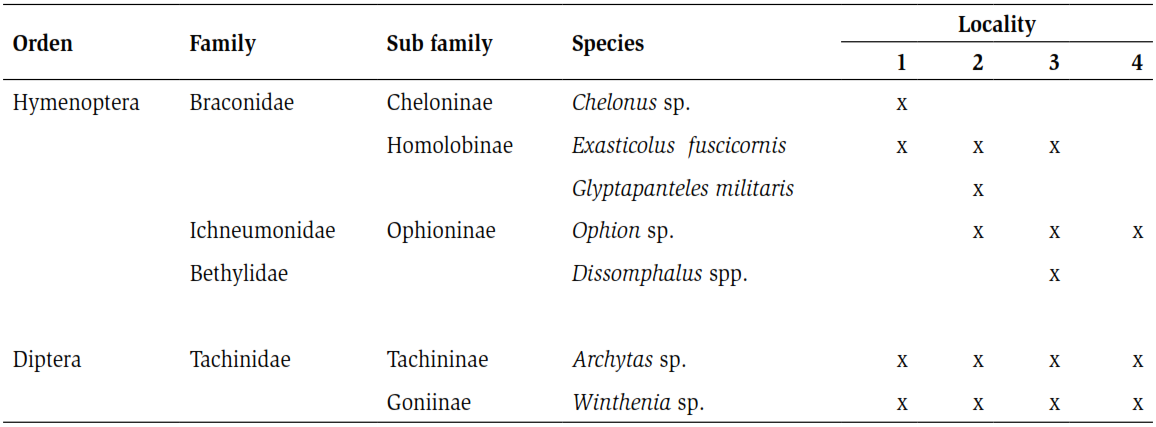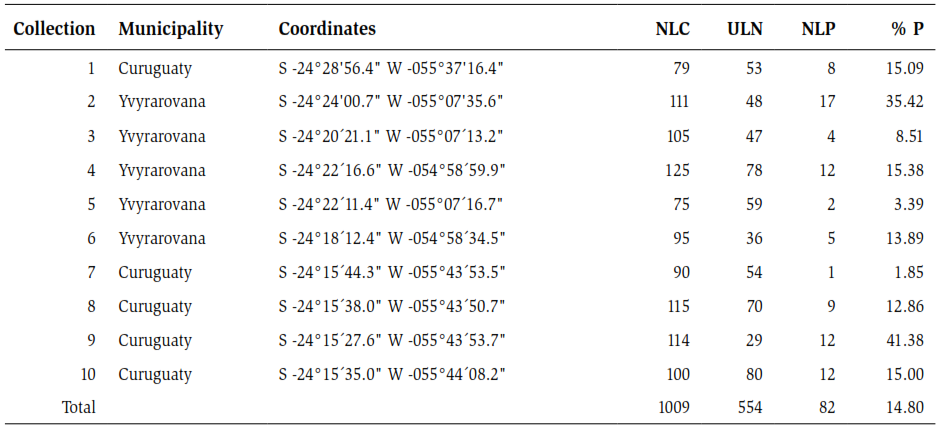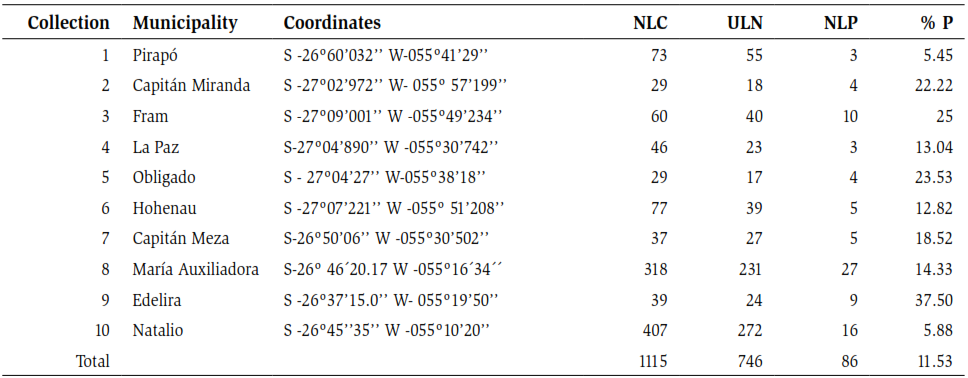Natural parasitism of Spodoptera frugiperda (Smith) (Lepidoptera: Noctuidae) in four departments in Paraguay
Parasitismo natural de Spodoptera frugiperda (Smith) (Lepidoptera: Noctuidae), en cuatro departamentos de Paraguay
*Corresponding author: claudia_c_cabral@hotmail.com
Received: 25 October de 2018 - Accepted: 23 November de 2018
Abstract
The impact produced by natural enemies on culture pests is a very important factor to consider at the moment of evaluating control methods. In this context, the characteristic fauna of a region and its influence on a particular pest are relevant data. This paper records the occurrence of parasitoids naturally associated with the fall army worm Spodoptera frugiperda (Smith, 1797) and their percentual impact calculated from rearing larvae of the host collected during the period 2015 – 2016 in Paraguay in the departments of Caaguazú, Alto Paraná, Canindeyú and Itapúa. The parasitoids recorded were: Dissomphalus spp. (Hymenoptera: Bethylidae), Exasticolus fuscicornis Cameron (Hymenoptera: Braconidae), Ophion spp. (Hymenoptera: Ichneumonidae), Archytas spp. (Diptera: Tachinidae) and Winthenia spp. (Diptera: Tachinidae).
Keywords: percentage parasitism; parasitoid fauna; maize; fall army worm
Resumen
El impacto que los enemigos naturales producen sobre las plagas de cultivos es un factor importante a tener en cuenta en el momento de evaluar los métodos de control a aplicar. En este contexto, la fauna propia de una región y su influencia sobre una plaga en particular son datos relevantes. Este artículo reporta la ocurrencia de parasitoides asociados de manera natural al gusano cogollero Spodoptera frugiperda (Smith, 1797) y su impacto porcentual calculado en la base de cría de larvas del hospedero recolectados durante el período 2015-2016 en Paraguay en los departamentos de Caaguazú, Alto Paraná, Canindeyú e Itapúa. Los parasitoides registrados fueron: Dissomphalus spp. (Hymenoptera: Bethylidae), Exasticolus fuscicornis Cameron (Hymenoptera: Braconidae), Ophion spp. (Hymenoptera: Ichneumonidae), Archytas spp. (Diptera: Tachinidae) y Winthenia spp. (Diptera: Tachinidae).
Palabras claves: porcentaje de parasitoidismo; fauna de parasitoides, maíz; gusano cogollero
Introduction
The cultivation of maize (Zea mays L.) in Paraguay is second in importance after soybeans, both in surface area (950,000 ha) and in grain production (4,985,881 Mg). The departments of Alto Paraná, Canindeyú, Itapúa, and Caaguazú are the leading producers of maize, accounting for 74.8 % of the area sown (DCEA, 2015). One of the main phytosanitary problems of this crop is the armyworm (S. frugiperda). The most widely used control method is the application of chemical products, which is often inefficient, in addition to increasing production costs and generating problems such as pest resistance and environmental contamination. In the search for alternatives to control this pest, the use of parasitoids arises as a strategy and an opportunity to protect the crop.
There are registers of the presence of Chelonus sp., Chelonus cautus Cresson, 1872; Chelonus insularis Cresson, 1865; Cotesia sp.; Cotesia marginiventris Cresson, 1865; laphygmae Vierecck, 1913 and Exasticolus sp. (Hymenoptera, Braconidae), Pristomerus spinator Fabricius, 1804; Campoletis flavicincta Ashmead, 1890 and Ophion sp. (Hymenoptera, Ichneumonidae) and Archytas incertus Giglio-Tos, 1893; Archytas marmoratus Townsend, 1915 and Lespesia archippivora Riley, 1871 (Diptera,Tachinidae) (Dequech et al., 2004; Figueireido et al., 2006 a,b; Cruz et al., 2009; Gutiérrez et al., 2013; Estrada et al., 2013). Because of the lack of information on parasitoid species associated with the armyworm in Paraguay, the objective of this study was to verify the occurrence of parasitoids that act as natural biological control agents of S. frugiperda larvae in the main maize producing departments.
Material and methods
Sampling points
Larvae of S. frugiperda from different instars were collected in corn crops in the 2014/2015 and 2015/2016 agricultural years, the number of larvae collected was variable. The collections were made in four departments: Caaguazú, Alto Paraná, Canindeyú and Itapúa, which are the central corn producing departments in Paraguay. The data of temperature, precipitation, altitude, localities sampled by department and number of samples collected are presented in table 1.

Larvae collection
The number of points sampled (table 1), was variable according to the presence of the pest. The gathering was carried out in each batch in a random manner, and an average of 100 S. frugiperda larvae was collected. The larvae collected in the field were identified in situ by morphological characteristics, then placed in 50 mL falcon tubes and placed in containers to be transferred to the Entomology laboratory of the Plant Protection Area samples) of the Faculty of Agricultural Sciences of the Universidad Nacional of Asunción. Once in the laboratory, the larvae of S. frugiperda were reared in plastic tubes (4.5 cm diameter x 7.5 cm long), with a temperature of 25 ± 5˚C, HR 70 ± 10 % and a photoperiod of 12 hours. The larvae were fed with corn leaves, which were replaced daily until the larvae completed their cycle or until the emergence of the parasitoids, the observations were made daily. The adult parasitoids were located in alcohol 70% labeled and identified.
Identification of parasitoids
The parasitoids were separated in order and family using the taxonomic keys of Evans (1964), Achtenberg (1979), Wharton et al. (1997), Brown et al. (2010), López-Martínez et al. (2011) and Rafael et al. (2012). Then the identification of gender and species was made in the laboratory of the Facultad de Ciencias Exactas y Naturales (FACEN, by its acronym in Spanish). The evaluations were based on the diversity and frequency of the parasitoid species emerged by location. The percentage of parasitism was calculated according to the formula proposed by García et al. (2013).

Where:
Number of Useful Larvae: difference between larvae recollected and killed by handling, leak or disease.
Number of Parasitized Larvae: only from useful larvae, whether the parasitoid emerged or not.
Results and Discussion
In the surveys carried out in the different departments, seven species of parasitoids were identified (table 2), the species collected and the percentage of parasitism obtained varied, depending on the locality and department. The rates of parasitism varied between 1.85 and 38.46%, occurring parasitism in all the areas sampled. The highest number of species collected was obtained in the departments of Canindeyú and Caaguazú, and the lowest diversity was observed in Itapúa.
The average percentage of parasitism in the department of Canindeyú was 14.80 % (table 3), with similar percentages found by Murúa et al. (2006) with 15% parasitism in the Argentine Northwest and 13.22 % in Yucatan-Mexico by Delfín et al. (2007).

The highest percentage of natural parasitism was 41.38 % in a harvest carried out by a small producer in the Curuguaty district. This higher percentage could be due to the fact that this producer had a polyculture in its premises and this regard, Figueiredo et al. (2006a) and Souza (2015), mention that a greater diversity of species of parasitoids is observed in polycultures, production system characteristic of small producers, however in large areas of monocultures an adverse influence is observed in relation to the presence of parasitoids. The species of parasitoids in the department of Canindeyu were: Dissomphalus spp. (Hymenoptera: Bethylidae), Exasticolus fuscicornis Cameron (Hymenoptera: Braconidae), Ophion spp. (Hymenoptera: Ichneumonidae), Archytas spp. (Diptera: Tachinidae) and Winthenia spp. (Diptera: Tachinidae) (table 2). Dissomphalus spp., Has not been reported as a parasitoid of S. frugiperda, this specimen constitutes the first record of this species associated with the armyworm in Paraguay. According to Redighieri and Azevedo (2006), Dissomphalus is the most abundant genus of the Bethylidae family in tropical forests and has a wide distribution in the Brazilian Atlantic Forest.

In the Department of Caaguazú (table 4), the average percentage of parasitism was 20.25 %, similar to those found by Dequech et al. (2004), Murúa et al. (2006), Murúa et al. (2009), Silva et al. (2011), Ordóñez et al. (2015a) and Ordóñez et al. (2015b) who obtained parasitism of 22.01; 19.94; 18.93; 2.3; 18.20 and 22.08 % respectively, in countries of America. Meanwhile, it is considered low when compared to the works of García et al. (2013), who mention parasitism of 62.40 % and 48.46 % respectively in Mexico. The percentage varied between 15.32 % in the municipality from February 3 to 36.45 % in the town of Dr. J. M. Frutos, which could be considered as acceptable since a large amount of non-selective chemical products is used in the area. Of the total of 152 emerged parasitoids, with five identified species (table 2), the speciesGlyptapanteles militaris was the most common in the repatriation and February 3, Archytas sp. was the most abundant in Yhú and Campo 9, while in Dr. J. M. Frutos the species with the highest number of emerged parasitoids was Winthenia sp. and in Caaguazú the most abundant was Ophion sp.
In the department of Alto Paraná, there was natural parasitism of 16.73 % (table 5), varying from 2.56 % (Itakyry) to 38.46 %. The average value could be considered low when comparing the results presented by Dequech et al. (2004), Pérez (2008) and Ordoñez et al. (2015a). For the Alto Paraná localities, the most abundant species was Exasticolus fuscicornis, while the least abundant was Chelonus sp. (table 1).
The average percentage in the department of Itapúa was 19.3% (table 6), the value similar to those presented by Molina et al. (2004), Silva et al. (2011) and García et al. (2013). The lowest percentage of parasitism was obtained in the municipality of Pirapó (5.50 %) and Natalio (5.90 %), while the highest value was obtained in the municipality of Edelira (37.50 %), the Low values levels may be related to the use of non-selective chemicals applied continuously in the area. In the monitored localities, the most abundant species was Whinthenia sp. followed by Archytas sp., while the least abundant species was Ophion sp. These results agree with the works of Murúa et al. (2006), which mention the Tachinidae family as the most abundant in Argentina.
The species Chelonus sp., Exasticolus fuscicornis, Glyptapanteles militaris; Ophion sp.; Archytas sp. and Winthenia sp. found in this research, have already been reported as parasitoids of S. frugiperda and other noctuids (Cave, 1993; Dequech et al., 2004; Estrada et al., 2013; Gutiérrez et al., 2013), in countries such as Brazil, Mexico , Honduras, Cuba. The exception is the species Dissomphalus spp., This being the first record of parasitoids in larvae of S. frugiperda.
It should be noted that these species have been reported as natural parasitoids. However, they are not produced on a large scale, and basic studies are needed to determine their potential as biological controllers as a basis for mass production.



Conclusions
Based on the results in the different departments where the gathering was made, it can be concluded that the natural occurrence of parasitoids in the cultivation of corn constitutes essential components of the regulation of the pest population, and the conservation of the same, through ecological management.
Seven species of S. frugiperda parasitoids were found, represented by the following four families and their respective species, Braconidae: Chelonus sp., Exasticolus fuscicornis, Glyptapanteles militaris; Ichneumonidae: Ophion sp.; Bethylidae: Dissomphalus spp. and Tachinidae: Archytas sp. and Winthenia sp.
Natural parasitism varied between departments, being 14.8 %; 20.25 %; 16.73 % and 11.53 % for the departments of Canindeyú, Caaguazú, Alto Paraná and Itapúa, respectively.
References
Achterneng, C. 1979. A revision of the subfamily Zelinae auct. (Hymenoptera, Braconidae). Tijdschrift voor Entomologie 122(7): 241-479.
Brown, B., Borkent, A., Cumming, J., Wood, N., Woodley, N. y Zumbado, A. 2010. Manual of Central American Diptera. Resench Press, Otawa.
Cave, R. 1993. Parasitoides larvales y rurales dé Spodoptera frugiperda (Smith) (Lepidoptera:Noctuidae) en Centro América con una clave para las especies encontradas en Honduras. Revista CEIBA 34(1): 33 – 56.
Cruz, I., Figueireido, M., Silva, R., Del Sarto, M. y Penteado-Dias, A. 2009. Monitoramento de parasitoides de lagartas de Spodoptera frugiperda (J. E. Smith) (Lepidoptera: Noctuidae) em Municipios de Minas Gerais, Brasil. Siete Lagunas. EMBRAPA Maíz y Sorgo, Siete Lagunas.
DCEA (Dirección de Censos y Estadísticas Agropecuarias, Py). 2015. Estimación de superficie, producción y rendimiento de cultivos agrícolas del Paraguay . Ministerio de Agricultura y Ganadería. _URL. Disponible en: http://www.mag.gov.py/Censo/SINTESIS%202015.pdf. Consultado: 12 de septiembre de 2015.
Dequech, S., da Silva, R. y Fiuza, L. 2004. Ocorrência de parasitóides de Spodoptera frugiperda (J. E. Smith) (Lepidoptera, Noctuidae) en lavouras de milho en Cachoeirinha, RS. Ciência Rural 34(4): 1235 – 1237.
Delfín-González, H., Bojorquez-Acevedo, M. y Manrique-Saide, P. 2007. Parasitoids of fall armyworm (Lepidoptera: Noctuidae) from a traditional maize crop in the Mexican state of Yucatan. Florida Entomologist 90(4): 759-761.
Estrada- Virgen, O., Cambero-Campos, J., Robles-Bermudez, A., Rios-Velasco, C., Carbajar-Casola, C., Isiorda-Aquino, N. y Ruiz-Cancino, E. 2013. Parasitoides y entomopatógenos nativos asociados al gusano cogollero Spodoptera frugiperda (Lepidoptera: Noctuidae) en Nayarit, México. Southwestern Entomologist 38 (2): 339-344.
Evans, H. 1964. A sinapsis of the American Bethylidae (Hymenoptera, Aculeata). Bulletin of the Museum of Comparative Zoology 132 (1):1 – 222.
Figueiredo, M., Martins- Dias, A. y Cruz, I. 2006a. Associação entre inimigos naturais e Spodoptera frugiperda (J. E. Smith 1797) (Lepidoptera: Noctuidae) na cultura do milho. Revista Brasileira de milho e sorgo 5(3): 340 -350.
Figueiredo, M., Martins- Dias, A. y Cruz, I. 2006 b. Relação entre a lagarta-do-cartucho e seus agentes de controle biológico natural na produção de milho. Pesquisa agropecuaria brasileira 41(12):1693-1698.
García, C. González, M. y González, A. 2013. Parasitismo natural de Braconidae e Ichneumonidae (Hymenoptera) sobre Spodoptera frugiperda (Lepidoptera: Noctuidae). Revista Colombiana de Entomología 39(2): 211-215.
Gutiérrez, A., Robles, A., Cambero, J., Santillan, C., Ortiz, M., Coronado, J. y Campos, M. 2013. Parasitoide de Spodoptera frugiperda (Lepidóptera: Noctuidae) encontrados en Nayarit, México. Southwestern Entomologist 40(3): 555-564.
López, V., Saavedra, M., Delfin, H., Figueroa, J. y García, M. 2011. A new species of the genus Exasticolus van Achterbeng (Hymenoptera: Braconidae: Homolobinae) from Mexico. Studies on Neotropical Fauna and Environment 46(1):59-62.
Molina, J., Carpenter, J., Lezama, R., Foster, J. y González, M. 2004. Natural distribution of Hymenopteran parasitoids of Spodoptera frugiperda (Lepidoptera: Noctuidae) larvae in México. Florida Entomologist 87(4): 461-472.
Murúa, G., Molina, J. y Coviella, C. 2006. Population dynamics of the fall armyworm, Spodoptera frugiperda (Lepidoptera: Noctuidae) and its parasitoids in northwestern Argentina. Florida Entomologist 89(2): 175-182.
Murúa, G., Molina, J. y Fidalgo, P. 2009. Natural distribution of parasitoids of larvae of the fall armyworm, Spodoptera frugiperda, in Argentina. Journal of Insect Science 9(20):1-17. 2009.
Ordoñez, M., Ríos, C., Berlanga, D., Acosta, C., Salas, M. y Cambero, J. 2005 a. Occurrence of natural enemies of Spodoptera frugiperda (Lepidoptera: Noctuidae) in Chihuahua, México (en línea). Florida Entomologist 98(3): 843 – 847.
Ordóñez, M., Bustillos, J., Loya, J., Ríos, C., y Jacobo, J. 2015 b. Parasitoides de Spodoptera frugiperda (J. E. Smith) (Lepidoptera: Noctuidae) en Chihuahua, México. Métodos en ecología y sistemática. 10(1): 67-78.
Pérez, E. 2008. Control biológico de Spodoptera frugiperda Smith en maíz. INISAV: Habana.
Rafael, J., Melo, G., de Carvalho, C., Constantino, R. 2012. Insetos do Brasil: Diversidade e Taxonomia. Holos Editorial, Ribeirão Preto.
Redighieri, E, y Azevedo, C. 2006. Fauna de Dissomphalus Ashmead (Hymenoptera, Bethylidae) da Mata Atlântica Brasileira, com descrição de 23 espécies novas. Revista Brasileira de Entomologia 50(3): 297-334.
Silva, F., Cruz, I., Figueiredo, M., Costa, M., Redoan, A., y Morato, J. 2011. Dinâmica populacional de parasitoides de Spodoptera frugiperda (J. E. Smith) (Lepidoptera: Noctuidae) en milho (Zea mays L.) cultivado no sistena orgânico de produção. Cadernos de Agroecología 6(2): 1-5.
Souza, A. 2015. Diversidade de himenópteros parasitoides en agroecossistenas. Maestria em Zoologia, Universidad de Brasilia, Brasilia, Brasil.
Wharton, R., Marsh, P. y Sharkey, M. 1997. Manual of the new world genera of the Family Braconidae (Hymenoptera). Madison: USA.
How to cite: Cabral-Antúnez, C.C., Garcete, B., Montiel-Cáceres, R.I., González-Vega, A.B., Cárdenas S.R., Armoa, N. y María Ramírez de López, M.B. 2018. Parasitismo Natural de Spodoptera frugiperda (Smith) (Lepidoptera: Noctuidae), en cuatro departamentos de Paraguay. Intropica 13(2): 130-136. DOI: http://dx.doi.org/10.21676/23897864.2655.